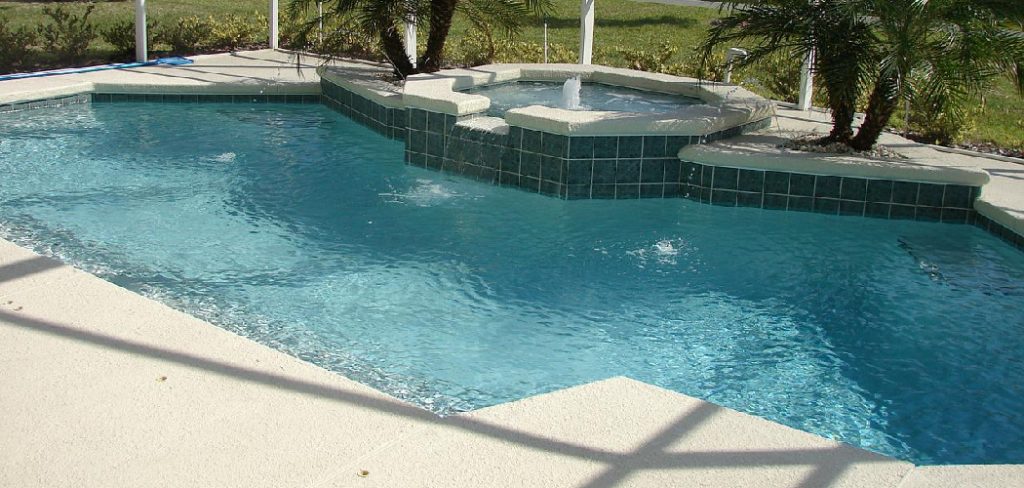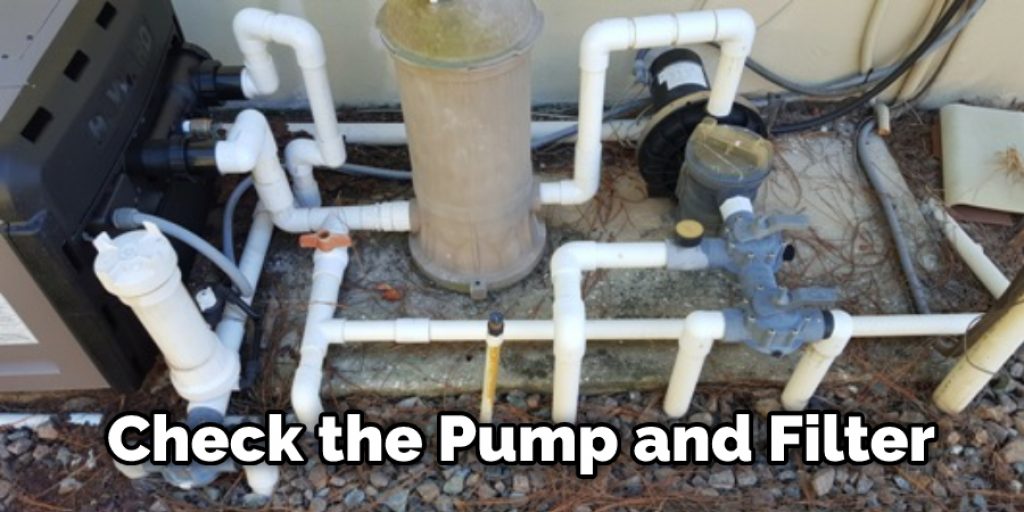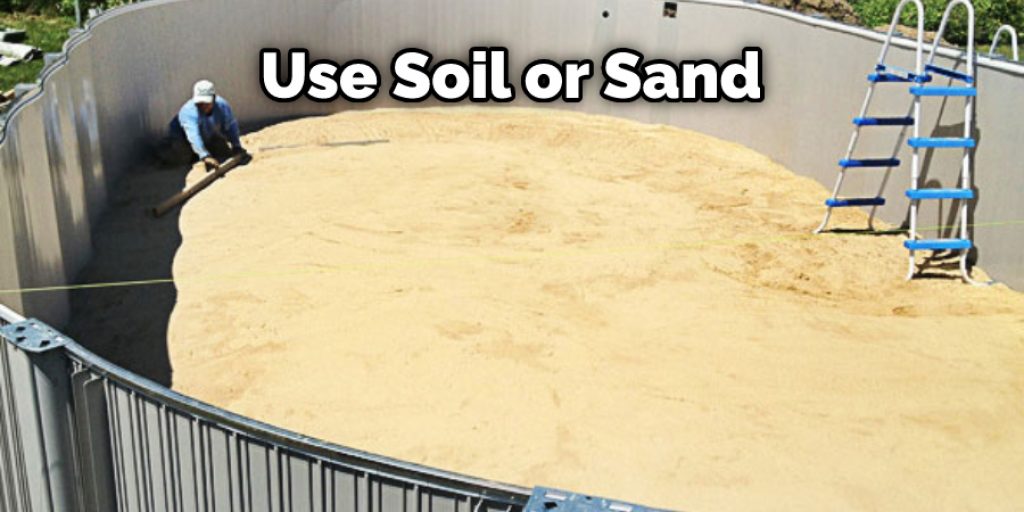Inground pools are often installed with a slight slope, from the shallow end to the deep end, to allow for proper drainage. However, over time, this slope can become uneven, compromising the pool’s structural integrity and creating unsafe conditions.

This blog post will show you how to fix unlevel inground pool using few methods. This will make your swimming experience much more enjoyable, and it will also help to keep your pool looking its best. Follow these simple steps, and your pool will be perfectly balanced!
Summary: Fixing an unlevel inground pool requires careful planning and assessing the problem. Solutions may include shimming the edges or adjusting the base depending on the severity.
Digging and filling can also be used to even out the pool. Resurfacing, replacing coping, and installing a pool cover can also help level a pool. For minor imbalances, a simple technique such as using a pool noodle or pump can do the trick.
5 Reasons That Causes Uneven Inground Pool
1. The Ground Has Shifted:
The most common reason that pools become unlevel is because the ground around them has moved. This can be caused by things like floods, earthquakes, or even just the natural expansion and contraction of the ground over time. If you live in an area where any of these things are common, you should have your pool inspected regularly to make sure it is still level.
2. The Pool Wasn’t Built Level:
Sometimes pools are not built level due to human error, but this can usually be corrected relatively easily. However, if the pool was installed by a professional, it’s worth getting in touch with them to see if they can rectify the situation.
3. The Pool Has Sunk:
Pools can gradually sink into the ground over time if they are not properly supported. This can happen for several reasons, including poor drainage, leaks, or even just the weight of the pool itself. If you notice that your pool is starting to sink, it is important to take action immediately to avoid further damage.
4. Problem With Pool’s Pump or Filter:
If the pool’s pump or filter isn’t working right, the water level can become uneven. This can happen with above-ground or inground pools. If you see that the water level in your pool isn’t the same all around, you should check the pump and filter to make sure they’re working like they should.

5. Bad Water Chemistry:
If the water in your pool is not properly balanced, it can cause the pool to become unlevel. This is usually due to a lack of chemicals, such as chlorine, in the water. Therefore, it’s important to regularly test the water in your pool and add chemicals as needed to maintain a balanced pH level.
You Can Check It Out to Fix Above Ground Pool Wall
How to Fix Unlevel Inground Pool: 17 Effective Steps
Step 1: Gather Necessary Tools and Materials
To fix an unlevel inground pool, you will need the following tools and materials:
- Long 2×4 lumber or a long straightedge
- Carpenter’s level or a laser level
- Shovel
- Tamping tool or plate compactor
- Wheelbarrow
- Sand or soil (depending on the type of pool)
- Landscaping fabric (optional)
Step 2: Assess the Pool’s Level
Using a long 2×4 or a straightedge, along with a carpenter’s level or a laser level, determine the extent of the unevenness in your inground pool. This will help you identify the areas that require leveling and provide you with an understanding of the amount of work necessary to correct the issue.
Step 3: Drain the Pool
Before beginning any leveling work, drain the pool completely. This will allow you to access the pool floor and make any necessary adjustments without the interference of water.
Step 4: Identify the High and Low Spots
Using your level, identify the high and low spots in the pool floor. Mark these areas with a waterproof marker or another form of visible identification. This will help you target the specific areas that require attention during the leveling process.
Step 5: Remove High Spots
Using a shovel, remove the high spots in the pool floor by digging out the excess material. Be sure to dig carefully and avoid puncturing or damaging the pool liner. Place the excess material in a wheelbarrow for disposal or relocation.
Step 6: Fill Low Spots
Fill the low spots in the pool floor with sand or soil, depending on the type of pool you have. If you have a vinyl liner pool, use sand; if you have a concrete or fiberglass pool, use soil. Spread the material evenly using a shovel, and then tamp it down using a tamping tool or a plate compactor. This will help create a firm, level surface for the pool floor.
Step 7: Recheck the Level
After filling in the low spots and removing the high spots, use your level to recheck the pool floor. If any areas are still uneven, repeat steps 5 and 6 as necessary until the entire pool floor is level.
Step 8: Install Landscaping Fabric (Optional)
If desired, install landscaping fabric over the leveled pool floor. This can help prevent weeds from growing through the pool liner and provide an additional layer of protection between the pool floor and the liner.
Step 9: Reinstall the Pool Liner
Once the pool floor is level, reinstall the pool liner according to the manufacturer’s instructions. Ensure that the liner is properly seated and free of wrinkles or air pockets.
Step 10: Refill the Pool
Refill the pool with water, ensuring that the water level is consistent around the entire perimeter of the pool. Monitor the water level as the pool fills to ensure that the pool remains level and does not shift.
Step 11: Inspect the Pool’s Surrounding Area
In addition to leveling the pool floor, it’s essential to inspect the surrounding area of the pool. Check for any unevenness or settling in the decking or patio area, as this can also contribute to an unlevel pool. If necessary, make adjustments to the surrounding area to ensure that it is level and stable.
Step 12: Perform Regular Maintenance level pool.
Regularly test the pool water for pH, alkalinity, and sanitizer levels, and make any necessary adjustments to maintain the recommended levels. Proper water chemistry can help prolong the life of your pool and ensure that it remains level and stable.
Step 13: Monitor Pool Water Chemistry
Maintaining proper pool water chemistry can help prevent damage to your pool liner and other pool components, which can contribute to an unlevel pool. Regularly test the pool water for pH, alkalinity, and sanitizer levels, and make any necessary adjustments to maintain the recommended levels. Proper water chemistry can help prolong the life of your pool and ensure that it remains level and stable.
Step 14: Keep the Pool Area Well-Drained
Proper drainage around the pool area can help prevent soil erosion and settling, which can contribute to an unlevel pool. Ensure that your pool’s drainage system is functioning correctly and that water is directed away from the pool and surrounding structures. This will help maintain the stability of the pool area and prevent future leveling issues.
Step 15: Inspect Pool Equipment and Accessories
Regularly inspect your pool’s equipment and accessories for signs of wear, damage, or shifting. This includes the pool pump, filter, ladder, diving board, and any other components that may impact the pool’s levelness. Replace or repair any damaged equipment as needed to maintain the stability of the pool.
Step 16: Watch for Signs of Soil Erosion
Soil erosion can cause the pool to become unlevel over time. Keep an eye on the surrounding landscape for signs of erosion, such as gullies, exposed tree roots, or areas where soil has been washed away. Address any erosion issues promptly to maintain the stability of the pool area and prevent further unevenness.
Step 17: Consider Professional Assistance
If you are unable to fix an unlevel inground pool on your own or if the problem is severe, consider hiring a professional pool contractor. They have the expertise and equipment necessary to accurately assess and correct an unlevel pool, ensuring that the issue is resolved safely and efficiently.
By following these steps and maintaining a proactive approach to pool care, you can fix an unlevel inground pool and prevent future leveling issues. Regular maintenance and attention to detail will help ensure that your pool remains a safe and enjoyable space for years to come.
You Can Check It Out To Fix Slippery Concrete Around Pool

Frequently Asked Questions
What Happens if an Inground Pool is Not Level?
When your pool is not level, the water appears to be at a different depth depending on where you are standing. This can cause unstable footing and potentially dangerous falls. Additionally, it can make it difficult for children or elderly adults to stay upright when in or around the pool.
To avoid these problems, ensure that your pool is properly leveled before Memorial Day by using a LEVELPool Leveler.
Can an Inground Pool Be Leveled?
The level of your pool will depend on a number of factors, including the type and size of your pool, the ground surface on which it is located, and the weight of the objects being placed in or around the pool. In general, however, you can try to adjust the pool’s level by adding or removing water, using a leveler or a sloped surface.
Can You Use a Tiller to Level Ground for Pool?
The optimal method of leveling ground for a pool may vary depending on your specific situation. However, if you are using a tiller to level the ground, be sure to use it in a manner that protects your turf and soil from damage. Always wear safety gear when operating machinery, and stay alert while working so that you can avoid accidents. Additionally, take care not to mow too close to any underground utilities or water lines — doing so could cause serious damage.
Do I Level My Pool Without Digging?
The best way to level your pool depends on the type of pool you have and the severity of the slope. However, some basic steps you can take to level your pool without digging include using a hand trowel or shovel, placing weights on the edges of the pool to push it down, or renting a digger. whichever approach works best for you, make sure to follow proper safety precautions and always wear protective gear.
What Kind of Sand Goes Under a Pool?
There are many types of sand that can be used for pool construction, but quartz is the most popular. This type of sand has a low running and seeping rate and is also non-toxic and environmentally friendly. Additionally, it dissipates heat quickly which reduces the possibility of water condensation on the walls of your pool.
Conclusion
In conclusion, there are a few ways to fix an unlevel inground pool. The most common solution is to use soil or sand to fill in the low areas and then adjust the water level. If this does not work, it may be necessary to excavate the area around the pool and rebuild it using concrete blocks or bricks.
Finally, if you have a vinyl-lined pool, you can adjust the liner by loosening the screws on one side of the pool wall and pulling it until the pool is level. We hope this blog post guided you on how to fix unlevel inground pool. If you have any questions or want to know more, then feel free to comment below!
